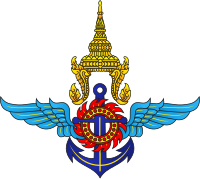Ministry of Defence (Thailand)
This article needs additional citations for verification. (May 2014) |
| กระทรวงกลาโหม | |
 Emblem of the Ministry of Defence | |
 Ministry of Defence HQ building, opposite Temple of the Emerald Buddha | |
| Ministry overview | |
|---|---|
| Formed | 8 April 1887 |
| Jurisdiction | Government of Thailand |
| Headquarters | Ministry of Defence HQ, Phra Nakhon, Bangkok 13°45′06″N 100°29′39″E / 13.7517°N 100.4942°E |
| Annual budget | 233,300 million baht (FY2020) |
| Minister responsible |
|
| Ministry executive |
|
| Website | Official website |
The Ministry of Defence (Abrv: MOD; Template:Lang-th, RTGS: Krasuang Kalahom), is a cabinet-level government department of the Kingdom of Thailand. The ministry controls and manages the Royal Thai Armed Forces to maintain national security, territorial integrity, and national Defence. The armed forces of Thailand are composed of three branches: the Royal Thai Army, Royal Thai Navy, and Royal Thai Air Force.[1]
Although the King of Thailand is the Head of the Royal Thai Armed Forces (Template:Lang-th), his position is only nominal. The ministry and the forces are administered by an appointed politician, the Minister of Defence, a member of the Cabinet of Thailand.
History
Initially, the Ministry was called Krom Kalahom (Template:Lang-th) and its head was called Samuha Kalahom (Template:Lang-th), and it was charged with the protection of the southern border. It was founded in the Ayutthaya period and was retained throughout the Rattanakosin period. The ministry in its current design was formed in 1887, by the order of King Chulalongkorn, to create a permanent military command. This was a result of the increasing threat posed by Western powers. The ministry was first housed in an old horse-and-elephant stable opposite the Grand Palace. A new European-style building was erected to house it. At first the ministry only commanded the army (founded in 1847), but then it incorporated the navy (founded in 1887), and finally, the air force (founded in 1913).[2]
In 1914, King Vajiravudh determined that the act providing for invoking martial law, first promulgated by his father in 1907, was not consistent with modern laws of war nor convenient for the preservation of the external or internal security of the state, so it was changed to the modern form that, with minor amendments, continues to be in force.[3]
Structure
| Office | Ministry of Defence | ||
|---|---|---|---|
| Minister รัฐมนตรีว่าการ |
Sutin Klungsang | ||
| Deputy Minister รัฐมนตรีช่วยว่าการ |
vacant | ||
| Permanent Secretary ปลัดกระทรวง |
General Sanitchanok Sangkhachan | ||
| Office | Royal Thai Armed Forces HQ | ||
| Chief of Defence Forces ผู้บัญชาการทหารสูงสุด |
General Songwit Noonpakdee | ||
| Office | Royal Thai Army |
Royal Thai Navy |
Royal Thai Air Force |
| Commander-in-Chief ผู้บัญชาการทหาร |
General Jaroenchai Hintao | Admiral Adung Phan-iam | Air Chief Marshal Punpakdee Pattanakul |
Departments
Departmental organisation
- Office of Minister of Defence
- Office of the Permanent Secretary for Defence
- Royal Thai Armed Forces
Associated organizations
- Armed Forces Academies Preparatory School
- National Defence College of Thailand
- Chulachomklao Royal Military Academy
- Royal Thai Naval Academy
- Navaminda Kasatriyadhiraj Royal Thai Air Force Academy
Other agencies
- Defence Technology Institute (Public Organisation)
- The War Veterans Department
- Bangkok Dock Company
Budget
| Organisation | FY2018 | FY2019 | FY2020 |
|---|---|---|---|
| Office of the Permanent Secretary | 9,250 | 10,063 | 10,300 |
| Headquarters | 16,802 | 17,352 | 17,900 |
| Defence Technology Organization | 1,227 | 1,240 | 1,300 |
| Army | 107,457 | 111,377 | 113,700 |
| Navy | 43,835 | 45,485 | 47,300 |
| Air Force | 39,931 | 41,609 | 42,900 |
| Totals | 218,503 | 227,127 | 233,300 |
The military augments its budgets through its ownership of golf courses, racetracks, boxing stadia, and radio and television stations.[5][6][7]
List of ministers
References
- ^ ประวัติความเป็นมาของกระทรวงกลาโหม
- ^ การจัดระเบียบราชการกระทรวงกลาโหม
- ^ Pakorn Nilprapunt (2006). "Martial Law, B.E. 2457 (1914)" (PDF). Thai Law Forum. Office of the Council of State. Archived from the original (unofficial translation) on 16 April 2013. Retrieved 21 May 2014.
Reference to Thai legislation in any jurisdiction shall be to the Thai version only. This translation has been made so as to establish correct understanding about this act to the foreigners
- ^ "Thailand's Budget in Brief Fiscal Year 2019". Bureau of the Budget. 20 December 2018. p. 84. Retrieved 3 December 2019.
- ^ a b "Prawit defends army spending". Bangkok Post. 3 December 2019. Retrieved 3 December 2019.
- ^ "Thanathorn gives up parliament roles". Bangkok Post. 30 November 2019. Retrieved 3 December 2019.
- ^ "FFP boss queries army wealth". Bangkok Post. 30 November 2019. Retrieved 3 December 2019.



